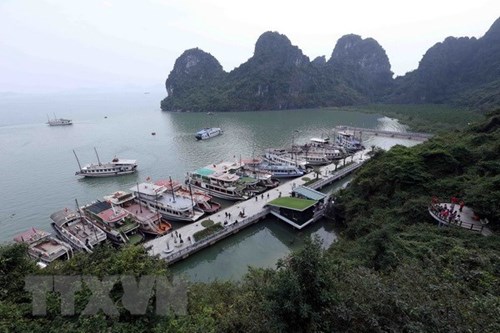Good planning and policies
Towards the goal of turning the province into a locomotive and an important growth pole of the northern key economic zone, Quang Ninh paid special attention to strategic planning work in the direction of shifting to a green growth model.
The province announced seven strategic blueprints on September 14, 2014, including a master plan on socio-economic development to 2020 with a vision to 2030.
    |
 |
|
Quang Ninh is working to build modern infrastructure for sea-based economy. |
Based on strategic blueprints for the sea-based and navigation economy, Quang Ninh looked for different ways to attract investment from other sources rather than the public budget, including in the form of Public-Private partnership (PPP), in order to build a system of transport infrastructure, helping enhance regional connectivity, creating motive power for economic growth in the northern key economic region and expanding trade linkages with countries in the Association of Southeast Asian Nations (ASEAN) and the world.
Since 2015, the province has invested more than VND 30 trillion, with VND 19.8 trillion coming from sources other than the budget, into transport infrastructure.
As of 2018, the province has put in place a modern and synchronous network of roads, connecting it with other localities in the northern key economic region such as Hanoi, Hai Phong, Thai Binh and Nam Dinh. It has just signed a PPP contract to construct the Van Don-Mong Cai highway worth nearly VND 11.2 trillion (USD 474.4 million).
More roads are being built
Besides transport infrastructure, Quang Ninh has revised plans for local ports and wharves serving coal transport, thus abolishing small-scale coal wharves and storage sites along the coast of Cua Luc and Ha Long Bays as well as in Cam Pha, Dong Trieu, Uong Bi and Hoanh Bo. New specialized roads have been built for coal transport, while new modes of transport such as railway and conveyor belts are being introduced to reduce pollution.
The province also ended the transport of cement and clinker on Ha Long Bay, and relocated residents in floating fishing villages in the bay to new homes in Ha Phong ward, Ha Long city, thus improving the environment in the bay, which is a UNESCO-recognized World Heritage site.
Good signs in attracting investment in sea-based economy
The standing board of Quang Ninh Party Committee has issued several resolutions on specific programs of actions to develop the sea-based economy. The resolutions identified the key tasks for the province, which are developing the system of ports, port services and maritime transport; sea-based industries, coastal economic zones and industrial parks; fisheries; sea tourism; science-technology and human resources.
Several investors, both foreign and domestic, have invested in sea ports in Quang Ninh, for example the SSA Holdings International Vietnam Inc which entered into a joint venture with Cai Lan Port Investment Joint Stock Company to build and operate Berths 2, 3 and 4 at Cai Lan Port; and Sun Group, which poured money into the Hon Gai port with the aim of turning it into an international port for cruisers.
In late 2016, the province also licensed the Dam Mac project, which aims to build a complex of sea port and industrial parks in Quang Yen town. The USD 315 million project is invested by the CDC Corporation (Cayman Islands), the Middle Utilities Company Pte., Ltd. (Singapore), and the Infra Asia Investment Ltd (Hong Kong).
Some other large-scale port projects have also been submitted to competent agencies for consideration.
Since 2017, the volume of container going through Quang Ninh’s sea ports has risen again. Local sea ports collected VND 10.3 trillion for the State budgets.
So far this year, sea ports in Quang Ninh handled nearly 59 million tons of cargo, up 37 percent from the same period last year.
Positive development in Quang Ninh’s sea-based economy is attributable to the provincial authorities’ sound decision to give priority to infrastructure.
Source: VNA